[外研版]七年级英语上册 精品导学案:module2unit2
外研版七年级上册英语Module 2 Unit 2 These are my parents (3)
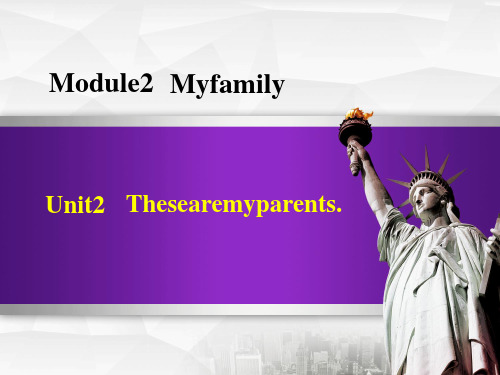
1.
2.
3.
Learningtolearn ThefullstopinEnglishisdifferentfromthatinChinese. Makenotesofthedifferenceswhenyoufindthem.
6
Answerthequestions. Writesentences.
知识点 1 Myfatherisanactor, andmymotheristhemanagerofathБайду номын сангаасatre.
考点1 actor/'æktə/n. (男) 演员
考向一 act的词形变化: actorn.(男)演员
↑ actv. 演出,扮演
↓ actressn. 女演员
eg:JackieChanisagoodactor. 成龙是一个好的演员。
1TheseareBetty’sparents.______c__ 2TheseareLingling’smotherandDaming’smother._______a_ 3ThisisTony’sfather.______f__ 4ThisisTony’smother. _____d___ 5ThisisDaming’sfather.______e__ 6ThisisLingling’sfather._____b___
外研版七年级英语上册Starter Module 2 (教学设计)

外研版英语七年级上册Starter Module 2Module 2 My English lessonUnit 1 Open your book .ⅠAnalysis of the text:This is the second module. Students should learn the classroom English in order to respond to the teacher’s words, and can corrrectly use them.ⅡArrangement of teaching in this moduleThree periods for this module, one period for one unit.ⅢTeaching focus:ⅰMaster language of useful expressions in the classroom .Key vocabulary and phrases:sit,down,open,book,listen,drow,put,up, stand, close.Useful sentences: Sit down.Stand up.Open your book.Close your book.Put up your hands.ⅱBe skilled in oral expression in the classroom.ⅣTeaching aims:ⅰ Function:useful expressions in the classroom.ⅱ Listening:Students can understand teacher’s words by listening.ⅲ Speaking:Students can use the sentences with others.ⅳ Reading:Students can understand the similar dialogues.ⅴ Writing: Students can write the useful words in their daily life.ⅤCharacter building:Motivate students’ interest in learning English.ⅥLearning strategies:Self study and Cooperate studyVII Teaching Procedures:Part I: Lead in:Step 1: Greeting with the students.Step 2: Use the classroom English in the class .Part II:Vocabulary study:Step 1:Play the recording and have them point out the words and phrases in Activity 2.Step 2: Play the recording again and have them read after the tape.Step 3: Have the students match the phrases and pictures in PPT.Step 4: Have the students match the phrases and pictures in Activity 4 and check their answer with their partner.PartⅢ: Dialogue study:Step1:Practise the dialogue with the whole class and have them make corresponding reacts.Step 2: Have students to practise the previous dialogue with their partner.Step 3: Work in pairs and do the Activity 2.Step 4: Work in pairs and practise the dialogue in Activity 2. Have some of them to perform their dialogue for the whole class.Unit 2 Good morning. I’m Chen Zhong.ⅠAnalysis of the text:In this text students will learn how to count number from one to ten.ⅡArrangement of teaching in this moduleThree periods for this module, one period for one unit.ⅢTeaching focus:ⅰMaster language of English numbers from 1 to 10.Key vocabulary and phrases: new, student, here, in, one, two, three, four, five, six, seven, eight, nine, ten, telephone, numberUseful sentences: -- Are you a new student here?-- Yes, I am.-- What class are you in?--I’m in Class 3.--What’S your number?--It’s…ⅱBe skilled in oral expression of English number from one to ten.ⅣTeaching aims:ⅰ Function:learn to how to ask others’ Class and telephone numbers .ⅱ Listening:Students can answer the questions by listening.ⅲ Speaking:Students can ask and answer in pairs.ⅳ Reading:Students can understand the similar dialogues.ⅴ Writing: Students can write their Class and telephone numbers.ⅤLearning strategies:Self study and Cooperate studyⅥTeaching Procedures:Part I: Lead in:Step1:Review the last lesson in the previous period by having the whole class play the dialoge in real situation .Step 2: Ask students to act with the classmates.Part II: Vocabulary study:Step 1:Play the recording and have them point out the words and phrases in Activity 1, 3 and 4.Step 2: Play the recording again and have them read after the tape.Step 3: Write the words in Activity 7.PartⅢ: Dialogue study:Step 1: Listen sentences in Activity 4Step 2: Teacher practise a dialogue with single student as follows: -- Are you a new student here?-- Yes, I am.-- What class are you in?--I’m in Class 3.--What’S your number?--It’s…Step 3: Work in pairs and practise the dialogue in Activity 6. Have some of them to perform their dialogues.Unit 3 This is my friend.ⅠAnalysis of the text:In this text students will learn how to introduce their ages and English numbers from eleven to twenty..ⅡArrangement of teaching in this moduleThree periods for this module, one period for one unit.ⅢTeaching focus:ⅰMaster language of say your age and learn the numbers from 11 to 20.Key vocabulary and phrases:old,twelve,eleven,thirteen,fourteen,fifteen, sixteen, seventeen, eighteen, nineteen, twenty, boy, girl, chair, bagUseful sentences: -- How old are you?--I’m twelve.-- How many boys are there?-- 15.ⅱBe skilled in oral expression of English number from eleven to twenty.ⅣTeaching aims:ⅰ Function:learn to use the numbers from 11-20.ⅱ Listening:Students can understand numbers from 11-20.ⅲ Speaking:Students can say numbers from 11-20.ⅳ Reading:Students can understand the similar dialogues.ⅴ Writing: Students can write the numbers from 11-20.ⅤLearning strategies:Self study and Cooperate studyVI Teaching Procedures:Part I: Lead in:Step1:Review the last two lessons in the previous period by having the whole class play the dialoges in real situation .Part II: Vocabulary study:Step 1:Play the recording and have them point out the words and phrases in Activity 1.Step 2: Play the recording again and have them read after the tape.Step3: Have the students match the words in Activity 3and check their answer with their partner.Step 4: Listen the dialogue in Activity 4 and point.Step 5: Write the right numbers in Activity 5.Step 6: listen to the tape and write the numbers in Activity 6.PartⅢ: Dialogue study:Step 1: Listen sentences in Activity 8 and practice.Step 2: Work in group of 4 and match in Activity 7, then have some groups of them to perform the dialoge for the whole class.。
StarterModule2Unit2(2)教案-外研版七年级英语上册
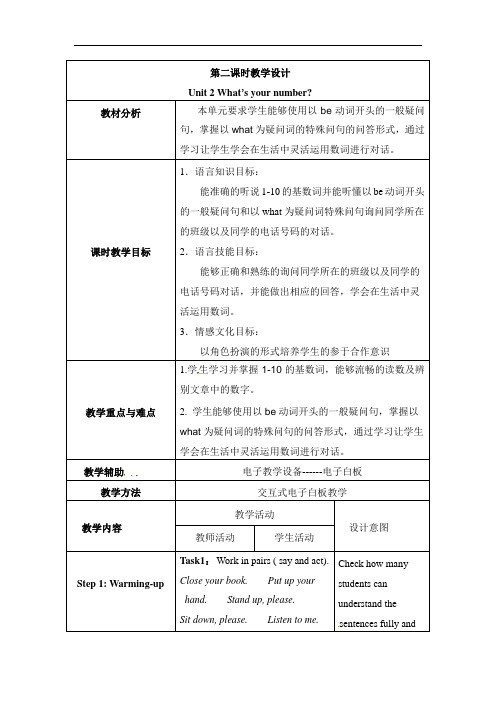
第二课时教学设计Unit 2 What’s your number?教材分析本单元要求学生能够使用以be动词开头的一般疑问句,掌握以what为疑问词的特殊问句的问答形式,通过学习让学生学会在生活中灵活运用数词进行对话。
课时教学目标1.语言知识目标:能准确的听说1-10的基数词并能听懂以be动词开头的一般疑问句和以what为疑问词特殊问句询问同学所在的班级以及同学的电话号码的对话。
2.语言技能目标:能够正确和熟练的询问同学所在的班级以及同学的电话号码对话,并能做出相应的回答,学会在生活中灵活运用数词。
3.情感文化目标:以角色扮演的形式培养学生的参于合作意识教学重点与难点1.学生学习并掌握1-10的基数词,能够流畅的读数及辨别文章中的数字。
2. 学生能够使用以be动词开头的一般疑问句,掌握以what为疑问词的特殊问句的问答形式,通过学习让学生学会在生活中灵活运用数词进行对话。
教学辅助电子教学设备------电子白板教学方法交互式电子白板教学教学内容教学活动设计意图教师活动学生活动Step 1: Warming-up Task1:Work in pairs ( say and act).Close your book. Put up yourhand. Stand up, please.Sit down, please. Listen to me.Check how manystudents canunderstand thesentences fully andfollow listening.Step 2: Lead-in Task2:Listen and chant (A ctivity3) then ask the students to play thechant.Check how manystudents canund erstand thewords fully an dfollow listening.Step3:Presentation Task3:Listen and repeat thenumbers (Activity 2) and then finishActivity 5 and Activity 7.Task4:Listen and read theconversation (Acti vity 1) and thencomplete the sentencesA: Hello. ____ you a new studenthere?B: Yes, I ____.A: ______ are you in?B: ____ in Class 3, Mr Chen’s class.1.Check how manystudents canunderstand thenumbers f ully andfollow listening.2.Check how manystudents can make upa dialogue.Step 3: While-reading Task 5 :Listen and read theconversation (Activity 4) and answerthe questions:1) What is Betty’s number?2) What is Tony’s number?3)What is Lingling’s number?Check how manystudents canunderstand thedialogue fully andfollow listening.Step4:After-readi ng Task 6:Try to retell the wholepassage. Check if students have understood the whole passage.Tas k 7:Work in groups. Let the students make up their own 1. Check how many students can make up。
七年级英语上册StarterModule2Unit2What’syournumber教案外研版
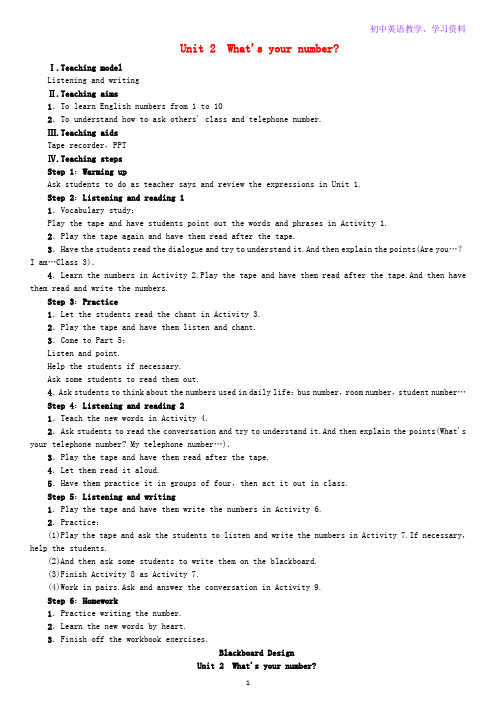
Unit 2 What's your number?Ⅰ.Teaching modelListening and writingⅡ.Teaching aims1.To learn English numbers from 1 to 102.To understand how to ask others' class and telephone number.Ⅲ.Teaching aidsTape recorder,PPTⅣ.Teaching stepsStep 1:Warming upAsk students to do as teacher says and review the expressions in Unit 1.Step 2:Listening and reading 11.Vocabulary study:Play the tape and have students point out the words and phrases in Activity 1.2.Play the tape again and have them read after the tape.3.Have the students read the dialogue and try to understand it.And then explain the points(Are you…?I am…Class 3).4.Learn the numbers in Activity 2.Play the tape and have them read after the tape.And then have them read and write the numbers.Step 3:Practice1.Let the students read the chant in Activity 3.2.Play the tape and have them listen and chant.3.Come to Part 5:Listen and point.Help the students if necessary.Ask some students to read them out.4.Ask students to think about the numbers used in daily life:bus number,room number,student number…Step 4:Listening and reading 21.Teach the new words in Activity 4.2.Ask students to read the conversation and try to understand it.And then explain the points(What's your telephone number? My telephon e number…).3.Play the tape and have them read after the tape.4.Let them read it aloud.5.Have them practice it in groups of four,then act it out in class.Step 5:Listening and writing1.Play the tape and have them write the numbers in Activity 6.2.Practice:(1)Play the tape and ask the students to listen and write the numbers in Activity 7.If necessary,help the students.(2)And then ask some students to write them on the blackboard.(3)Finish Activity 8 as Activity 7.(4)Work in pairs.Ask and answer the conversation in Activity 9.Step 6:Homework1.Practice writing the number.2.Learn the new words by heart.3.Finish off the workbook exercises.Blackboard DesignUnit 2What's your number?1.one,two,three,four,five,six,seven,eight,nine,ten 2.—Are you a new student here?—Yes,I am.3.—What class are you in?—I'm in Class 3.。
外研版七年级英语第二模块第二单元英语学案

Module 2 My familyUnit 2 there are my parents.一、必背单词bus 公共汽车station 站,车站hospital 医院hotel 宾馆酒店police 警察theatre (theater)剧院actor 男演员driver 司机,驾驶员manager 经理nurse 护士policeman (policemen)男警察we 我们an 一(个,件)job 工作same 相同的,同一的二、必背短语on the left 在左边;在左侧on the right 在右边;在右侧in front of 在……前面a big family 一个大家庭三、汉译英我是贝蒂金。
这是我的父母。
我们是美国人。
我爸爸是一名演员,我的妈妈是一家剧院的经理。
我是李大明。
这是我的父母。
我们是中国人。
我爸爸在警察局工作。
他是一名警察,我的妈妈是一名护士。
我叫托尼史密斯,我是英国人。
这是我的妈妈。
他是一所学校的英语老师。
这是我的爸爸。
他是一家宾馆经理我是王玲玲。
我是中国人。
我的妈妈是一名护士。
他和大明的妈妈在一同家医院。
我的爸爸是北京的一名公共汽车司机。
四、重点句型1.My father is an actor,and my mother is a manager of a theatre考点:actor (男)演员act 演出;扮演actress 女演员例如:Jackie is a good actor.成龙是个好演员。
构词法:某些动词+r/or/er可构成名词,表示“从事某种职业的人”Teach→teacher work→worker drive→driver write→writer visit→visitor2.My father’s job is at a police station.考点:job 工作辨析job和work例如:he has a job. 他有一份工作。
2019秋外研版七年级英语上册教案:Starter Module 2 My English lesson Unit 2 What’s your number
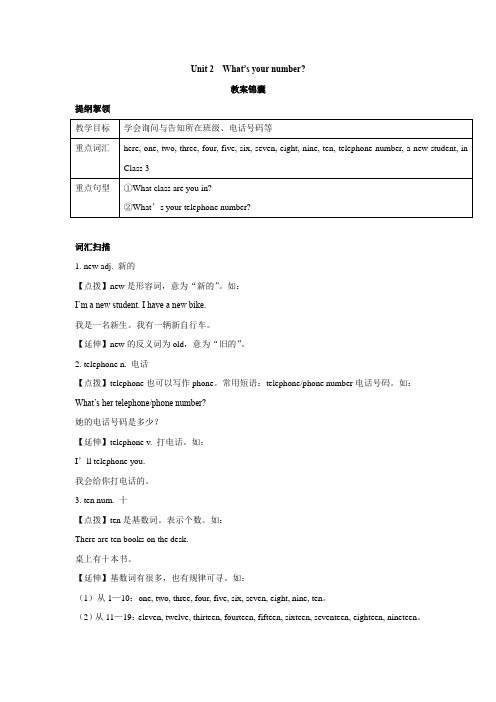
Unit 2 What’s your number?教案锦囊提纲挈领词汇扫描1. new adj. 新的【点拨】new是形容词,意为“新的”。
如:I’m a new student. I have a new bike.我是一名新生。
我有一辆新自行车。
【延伸】new的反义词为old,意为“旧的”。
2. telephone n. 电话【点拨】telephone也可以写作phone。
常用短语:telephone/phone number电话号码。
如:What’s her telephone/phone number?她的电话号码是多少?【延伸】telephone v. 打电话。
如:I’ll telephone you.我会给你打电话的。
3. ten num. 十【点拨】ten是基数词。
表示个数。
如:There are ten books on the desk.桌上有十本书。
【延伸】基数词有很多,也有规律可寻。
如:(1)从1—10:one, two, three, four, five, six, seven, eight, nine, ten。
(2)从11—19:eleven, twelve, thirteen, fourteen, fifteen, sixteen, seventeen, eighteen, nineteen。
这里除eleven, twelve, thirteen, fifteen, eighteen为特殊形式外,fourteen, sixteen, seventeen, nineteen都是由其个位数形式后添加后缀-teen构成。
(3)从20—99整数几十中除twenty, thirty, forty, fifty, eighty为特殊形式外,sixty, seventy, ninety都是其个位数形式后添加后缀-ty构成。
表示几十几时,在几十和个位基数词形式之间添加连字符“-”。
外研版七年级英语上册Module2教案

外研版七年级Module 2 My family Unit 1 Is this your mum?教学设计一、教学背景分析:本课课型为听说课。
教材从谈论一张全家福开始,介绍了表示家庭成员的单词;对话内容围绕着玲玲询问托尼的家庭情况展开,介绍人物之间的关系,同时也呈现了英语中询问他人家庭情况的语言。
学生能够在真实的语境中感知目标语言的用法。
二、学情分析:七年级的学生性格特点是有强烈的好奇心,求知欲并且活泼好动,参与热情很高,面对可塑性很强的学生,教师一定要保护他们学习英语的热情。
在本课教学中我通过师生对话、生生操练、小组活动以拉近师生、生生之间的距离,激发学生的学习兴趣,调动学生积极性,发挥学生潜力,达到最佳学习效果的目的。
三、教学内容分析(1) 生词和短语Unit brother cousin daughter family father grandfathergrandmother grandparent parent mother sister son uncle photo these they mum left dad right who woman next husband front those a photo of on the left on the right next to in front of(2) 重点句子1)Is this your family? Yes, it is.2)This is a photo of Tony's family.3)What a big family!4)My mum's parents are on the left.5)Those are Paul's son and daughter.(3) 听懂有关家庭介绍的简短对话,辨认对话中的人物关系。
用指示代词来介绍自己的家庭,询问他人的家庭情况四、教学重难点:"this, that, these, those"的用法。
初中英语外研版七年级上册《Starter Module 2 Unit 2 Wha教学设计
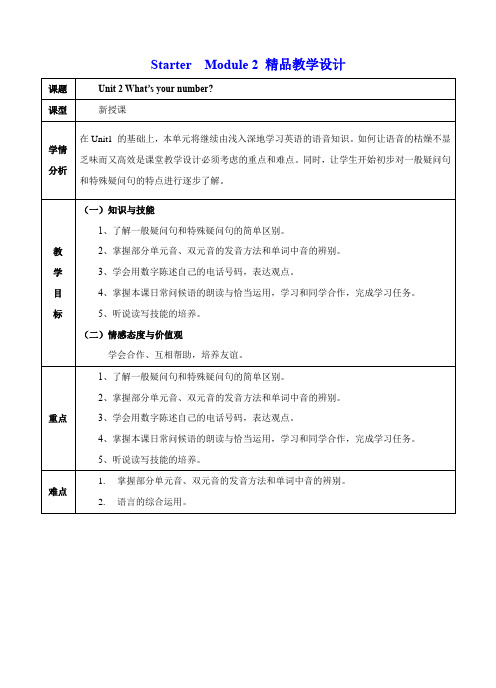
7、要求学生两人组,完成Activity9的对话表演。
8、引导学生归纳重难点,进行课堂小结
1、学习数词及本课生词,学读元音的发音。
参与游戏,辨别单词发音。
2、听读互动
3、听读讨论重点句子,背诵并参与游戏。
教学过程
教学环节
教师活动
学生活动
设计意图
Step1:
Warming-up
课前互动
展示听力内容,教师朗读句子,要求学生填写所缺单词。
听写
基础过关,培养听写能力。
Step2:
Foundation
and ability
夯实基础
提升能力
1、展示数字1--10,教读发音。组织学生参与游戏,播放“The ten Indians”,补充教学剩余生词并检查。引导学生自我拼读生词中说出现的元音,组织学生参与游戏活动“小兔回家”
4、独立完成预设表格,跟读对话,分组表演对话。
5、听并完成Activity 5。
6、听并写,完成Activity 6--8并展示自己的习作。
7、两人组队,各自写下个人的号码,但要保密。对方需根据自己的回答正确写出该号码。
9、回顾本节重点,大胆发言。
生词拼读、语音过关,寓教于乐。
巩固重点句子,提高学习兴趣,培养自信心。
2、播放Activity 3录音,组织学生课堂互动。
3、播放Activity 1录音,要求学生跟读,大声背诵。然后参与游戏:小火车,快快开。
4、要求学生自我阅读Activity4,填写预设表格并检查答案,给予必要的鼓励。播放录音,要求学生跟读、分组读,最后四人组课堂表演对话。
外研版七年级英语上册教案 Starter Module 2Unit 2

Unit2 What’syournumber?◇目标导航◇预习指导一、方法指导1.学生自主预习教材PS10~S11中的新单词(见词汇表P88),掌握单词读音及汉语意思。
2.预习课文中的对话,能自主朗读对话并翻译对话。
二、预习检测Ⅰ.汉译英1.一one2.二two3.三three4.四four5.五five6.六six7.七seven 8.八eight9.九nine 10.十ten11.学生student 12.新的newⅡ.根据汉语意思完成句子,每空一词1.你是这儿新来的学生吗?Are you a new student here?2.你在几班?What class are you in?3.我在三班。
I’m in Class 3 .4.——你的电话号码是多少?——是726 815。
—What’s your telephone number ?—It’s seven two six,eight one five.课堂教学Step1 情景导入老师带领学生复习学过的日常交际用语。
Step2 听对话并跟读,完成教材任务1,2和31.听录音,跟读,完成教材任务1。
(1)播放录音,训练学生听力,熟悉本课问句及答语。
(2)再次播放录音,让学生跟读,同时理解对话内容。
(3)老师重点难点,帮学生理解下列句子及用法: —Are you a new student here?—Yes,I am.—What class are you in?—I’m in Class 3.2.听录音并跟读,完成教材任务2。
(1)播放录音并跟读,学习数字1—10。
(2)学生先自主读数字,之后老师提问,先按顺序说,然后随机抽取数字说,以巩固这些英语单词。
3.听录音,完成教材任务3。
播放录音,学生跟着录音唱,老师解释下面句子的汉语意思。
Once I caught a fish alive.一旦我抓到了一条活的鱼。
Then I let it go again.那么我就让它再回到水里去。
秋外研版七年级上册module2《my english lesson》优秀教案(重点资料).doc

Starter Module 2 My English lessonUnit 1 Open your book.学习内容:Starter Module 2 My English lessonUnit 1 Open your book.学习目标:1、To review the words and useful expressions in Unit 1 of Starter Module 2.2、To learn to use everyday English in this unit.3、To keep them in your mind.学习重点:1、词汇:sit, down, open, book, listen, draw, put, up, hand, stand, close.2、句型: --- Sit down. / Stand up.--- Open your book. / Close your bok.--- Put up your hand.学习时间:2课时学习方法:自主、合作与探究法学习过程:Step 1 Warming - up / Lead - in* 教师走进教室,学生起立向老师问好,教师问候学生,然后可以说:“Please sitdown.”并配以手势来请同学们坐下。
教师在真实的语境中引入了“Please sitdown.”这个重点句型,在手势的帮助下,学生应该能够理解这个句子的意思。
Step 2 Listening and reading1、Activity 1 Listen and read.2、Activity 2 Listen and repeat.3、Activity 3 Listen again and do.(1)播放录音,让学生做出相应的动作。
(2)在学生比较熟悉之后,变换形式进行游戏。
Step 3 Practice1、Activity 4 Match.* 学生个体活动,完成匹配。
外研版七年级英语上册《Module2Unit2Thesearemyparents》说课稿

外研版七年级英语上册《Module 2 Unit 2 These are my parents》说课稿一. 教材分析外研版七年级英语上册《Module 2 Unit 2 These are my parents》是一篇以介绍家庭成员为主题的文章。
通过学习本节课,学生可以掌握家庭成员的英文表达,以及如何用英语介绍自己的家人。
教材内容丰富,插图生动,有利于激发学生的学习兴趣。
二. 学情分析七年级的学生已经掌握了基本的英语语法和词汇,对于学习新的家庭成员词汇和句型具有一定的接受能力。
但部分学生可能对英语表达仍存在一定的恐惧心理,需要在教学中加以鼓励和引导。
三. 说教学目标1.知识目标:学生能够掌握家庭成员的英文表达,学会用英语介绍自己的家人。
2.能力目标:学生能够听懂、会说、会读本节课的生词和句型,提高英语表达能力。
3.情感目标:通过本节课的学习,学生能够增进对家庭的认识,增强对家人的感情。
四. 说教学重难点1.重点:家庭成员的英文表达,用英语介绍自己的家人。
2.难点:正确运用句型和词汇描述家庭成员的特点。
五. 说教学方法与手段1.情景教学法:通过设置 realistic situations,让学生在实际情境中学习和运用英语。
2.任务型教学法:通过 group work 和 pr work,让学生在完成任务的过程中,提高英语交际能力。
3.多媒体教学手段:利用课件、图片、视频等,丰富教学手段,提高学生的学习兴趣。
六. 说教学过程1.Lead-in:通过提问方式引导学生谈论自己的家人,激发学生的学习兴趣。
2.Presentation:教师展示文章图片,引导学生说出家庭成员的英文表达,介绍文章主人公及其家人。
3.Practice:学生进行 group work 和 pr work,运用所学句型和词汇介绍自己的家人。
4.Consolidation:学生观看视频,回答问题,进一步巩固所学知识。
5.Summary:教师总结本节课所学内容,强调重点。
外研版七年级英语上册《tarter Contents Module 2 Unit 2 What's your number.》精品教案_18
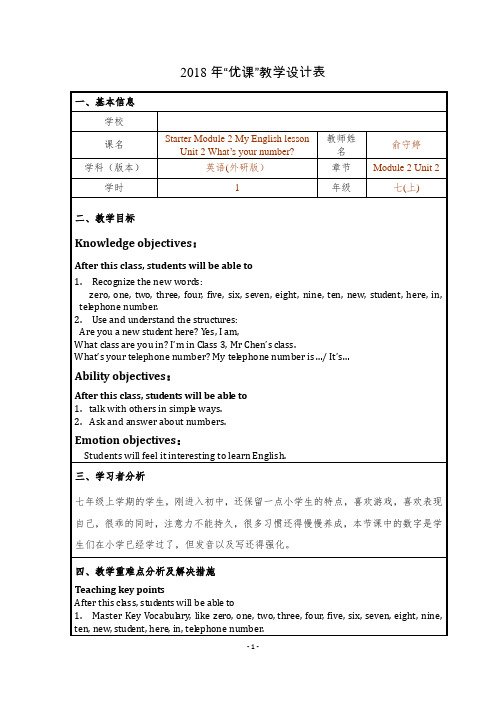
训练并巩固学生对数字的敏感度。
Read 20 phone numbers on your parent’s phone number list.
回家读爸爸或妈妈的号码簿。
Blackboard Design
2.Listen.
Who are they?
3.Read
What aretheirtelephone numbers?
4.Find the rules.
学生观察图片并描述图片,听人名,再阅读,读懂问号码的对话。最后再总结英语书写号码的规则。
电子白板的展示功能,插播音频功能。
Practice
提升学生对数字的敏感度,由听数字逐渐过渡到写数字。再由写阿拉伯数字过渡到写英文,由写两三个提升到六个。
五、教学设计
教学环节
环节目标
教学内容
学生活动
媒体作用及分析
Free talk
问候,复习
Teacher says the instructions, students do them.
与老师ቤተ መጻሕፍቲ ባይዱ由交流
直观电子课本的截图复习。
Lead-in
引出生词和句型
Let students enjoy a short video about our new school, Ask students to answer:
学生说出问号码的问句,并和老师一问一答进行句型的操练。
用游戏的方式激发学生参与数字练习的热情。
利用希沃白板中的课堂活动功能让学生匹配生活中重要的数字,拓展学生的知识面。
Look, listen, and read
读懂问号码的对话。培养学生的读图能力,分析总结能力。
1.Look
2022年外研版七年级上册Module 2 Unit 2精品教案
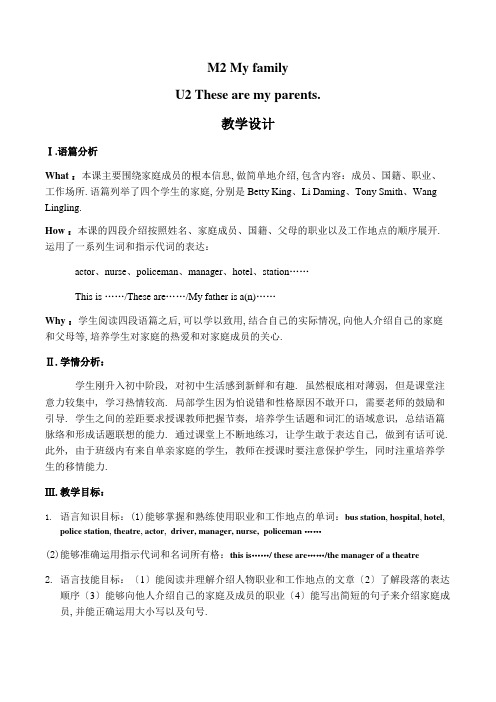
M2 My familyU2 These are my parents.教学设计Ⅰ.语篇分析What :本课主要围绕家庭成员的根本信息, 做简单地介绍, 包含内容:成员、国籍、职业、工作场所. 语篇列举了四个学生的家庭, 分别是Betty King、Li Daming、Tony Smith、Wang Lingling.How :本课的四段介绍按照姓名、家庭成员、国籍、父母的职业以及工作地点的顺序展开.运用了一系列生词和指示代词的表达:actor、nurse、policeman、manager、hotel、station……This is ……/These are……/My father is a(n)……Why :学生阅读四段语篇之后, 可以学以致用, 结合自己的实际情况, 向他人介绍自己的家庭和父母等, 培养学生对家庭的热爱和对家庭成员的关心.Ⅱ.学情分析:学生刚升入初中阶段, 对初中生活感到新鲜和有趣. 虽然根底相对薄弱, 但是课堂注意力较集中, 学习热情较高. 局部学生因为怕说错和性格原因不敢开口, 需要老师的鼓励和引导. 学生之间的差距要求授课教师把握节奏, 培养学生话题和词汇的语域意识, 总结语篇脉络和形成话题联想的能力. 通过课堂上不断地练习, 让学生敢于表达自己, 做到有话可说. 此外, 由于班级内有来自单亲家庭的学生, 教师在授课时要注意保护学生, 同时注重培养学生的移情能力.Ⅲ.教学目标:1.语言知识目标:(1)能够掌握和熟练使用职业和工作地点的单词:bus station, hospital, hotel,police station, theatre, actor, driver, manager, nurse, policeman ……(2)能够准确运用指示代词和名词所有格:this is……/ these are……/the manager of a theatre2.语言技能目标:〔1〕能阅读并理解介绍人物职业和工作地点的文章〔2〕了解段落的表达顺序〔3〕能够向他人介绍自己的家庭及成员的职业〔4〕能写出简短的句子来介绍家庭成员, 并能正确运用大小写以及句号.3.学习策略目标:〔1〕教学步骤由易到难, 由听说到读写, 循序渐进, 利于唤起学生的认知,开展思维〔2〕尽可能多地利用课堂进行交际训练, 提高学生的表达能力〔3〕利用音频和视频等音像资源, 刺激学生的多感官参与学习, 丰富课堂教学.4.情感文化目标:通过介绍家庭情况, 〔1〕培养学生对家庭的热爱和对家庭成员的关心〔2〕培养学生对家庭不幸同学的同情和理解.Ⅳ.教学重难点:1. 学生会使用新授的单词和表达, 职业和工作地点能够一一对应.2. 学生通过阅读, 学会如何介绍自己的家庭成员的职业和工作地点.3. 仿照四段语篇, 引导和鼓励学生介绍自己的家庭, 加强亲情的感知.Ⅴ.教学过程:Step 1 . Warming up - listening to a songPlay a song Be what you wanna be and speak out some jobs in it .播放歌曲, 唤醒课堂.【设计意图】用歌曲来活泼课堂, 迅速激活话题, 吸引学生的注意力, 并且锻炼听力. Step 2 . Pre-readingLabel the places and people in the pictures with the words and expressions. (Activity 1)【设计意图】通过单词和图片的匹配帮助学生在头脑中建立两者的联系, 减少汉语的干预.为后面的学习扫除障碍, 提高阅读效率.Step 3. While- reading1. Fast reading :Read loudly and match main idea with each paragraph.Para1. Betty King’s familyPara2. Tony Smith’s familyPara3. Wang Lingling’s familyPara4. Li Daming’s family【设计意图】通过快速阅读, 迅速找出主要人物, 并进行匹配, 培养学生获取信息的能力.2. Careful reading: Read and answerPara 1. 1.What is Betty’s father?2.Where does Betty’s mother work?Para 2 1. They are from England.2.Tony’s mother is an English teacher at a school.3.Tony’s father is a hotel manager.Para 3 1._Daming’s father is _______.2.--- Daming ’ father work at_______.Para 4 1.Wang Lingling’s mother is a _______ at a hospital.A doctorB nurse2.is a bus driver in Beijing.A Dam ing’s fatherB Wang Lingling’s father【设计意图】细读局部采取分段阅读的方式, 每一段都准备了相应的问题, 问题形式涉及主观问答、判断、填空和单项选择, 主要考察学生获取信息和整合信息的能力. 在阅读的过程中, 稳固词汇和指示代词. 在每一段的阅读中, 按照姓名、家庭成员、职业、地点的顺序进行描述, 进而让学生能够复述出来.Step 4 Post -reading1.根据表格〔Activity 4〕,可以复述任一小段.【设计意图】充分熟悉课文, 锻炼语言输出能力.2.Ask and answer questions in pairs .记者采访环节, 可参加其他问题.What’s your father’ s name?What’s your father’ s job?What’s your mother’ s name?What’s your mother’ s job?3.Talk about your family and their jobs 介绍自己家人.(This is…/T hese are…)【设计意图】帮助学生运用this is和these are句型准确介绍自己家人工作及他们的工作地点.4. Do you love your family? What can you do to love your family?【设计意图】通过介绍家人升华学生情感,引发学生思考:需要怎样做来回馈家人给予的爱?培养学生学会感恩, 学会关心家人的思想品质.Step 5 Homework.Must do: Write a short passage about your family in the notebooks, using what we learnt today. Thenshare with your group members.Can do : When you introduce your family ,not only introduce those four aspects, you can also say someother information you know, such as hobby、habit、individuality……【设计意图】分层作业可以最大程度上的让学生的语言能力和学习能力得到锻炼, 一方面,可以夯实根底, 稳固课堂教学;另一方面, 鼓励学生挑战自己, 试着做提高作业.Ⅵ.板书设计:Module2 My family Unit2 These are my parents.This is …… These are ……Betty Daming Tony LinglingFather actor policeman manager bus driverMother manager nurse English teacher nurseⅦ.教学反思:我本次课内容选自外研版英语教材七年级上册M2 My family U2 These are my parents. 现在将实际授课之后的体会和发现的问题结合课堂教学环节做如下反思:优点:1.通过播放歌曲, 让学生放松身心, 同时快速进入本课的主题.2.课堂中通过单独提问、二人对话、小组讨论的形式, 教学表达一学生为主体.3.在阅读之后, 侧重情感的渗透, 培养学生关爱他人, 感恩父母之情.缺乏:1.由于个人经验缺乏, 教学中忽略了表情亲和, 导致学生表现拘谨, 怯于发言.2.在post-reading中, 应该给与学生更多的展示时机来进行语言的输出.3.在分段阅读时, 应该给与学生更多的时间去理解和练习复述, 从而照顾到更多的后进生.4.有一次多媒体的失误操作, 以后要防止此类失误.通过本节课我深深的感到, 教学永远是一门无止境的艺术, 缺乏之处在以后的教学中一定注意加以改善. 在教学的路上, 我会时刻反思自己, 总结经验, 让自己成为一名优秀的教师.活学活用—Today is fine. What about________ a picnic?—That's a good idea. Let's go.A.have B. to haveC.having D.HasC2.What’s your name?英语中,当想知道对方叫什么名字时,可用句型"What’s your name? "进行询问,其答语一般用"My name is + 姓名.".—What’s your name?—My name’s Gao Jing.3.I’m twelve years old...years old, 表示“...岁〞. 有时候years old 可以省略, 只用数字来表达年龄即可. 如:Her dog is three.对该句型提问可用:How old ...? 它是英语中一个较重要的句型,主要用来询问某人的年龄,其答语通常用"主语+ am / is / are + 年龄.--How old are you?--I am thirteen (years old).活学活用--How old are you?--I am .A.ten B. Susan C.nice D.Class4A4.Nice to meet you用于第一次见面时说的话, 一般的场合都可以. 比较正式.--Nice to meet you--Nice to meet you, too.语法一、人称代词1.用来代替上文提到的人或物的代词称为人称代词. 人称代词又分为主格和宾格两种. 如下表:2.主格代词在句中作主语常置于句首;宾格代词在句中作宾语.活学活用用适当的人称代词填空1.Hi, ________ am Wang Nana.2.This girl is my friend. ________ is 10 years old.3.That boy is from England. ________ is Jack.4.—Are ________ from Class One, Lucy?—Yes, ________ am.5.This is our teacher, Mr Zhang. ________ is 36 years old.1. I2. She3. He4. you; I5. He二、be动词的一般现在时1.be动词的含义及用法am/is/are是动词be的一般现在时形式, 根本意思为“是〞, 用来说明年龄、身份、状态等.2.一般现在时的根本用法:(1)肯定句式:主语+am/is/are +其他.例如:I am a student.我是一名学生.He's a doctor.他是一位医生.It's a desk.它是一张桌子.They are my friends. 他们是我的朋友.(2)否认句式:________+________+________+其他.(注意:is, are可与not缩写为isn't, aren't, 但am 不可与not缩写) 主语; am/is/are; not(3)一般疑问句句式:________+________+其他?Am/Is/Are; 主语;肯定答复:________, 主语+be(am/is/are).Yes;否认答复: No, 主语+be(am/is/are)+not.例如:—Is this a map? 这是一张地图吗?—Yes, it is.是的, 它是.—Are they from Xinjiang? 他们来自新疆吗?—No, they aren't.不, 他们不是.【温馨提示】肯定答复中的be动词不能与前面的代词缩写;否认答复中的not可以与前面的be动词缩写, 但am不能与not缩写.[口诀] 我(I)用am, 你(you)用are, is 连接他(he)、她(she)、它(it). 单数词用is, 复数词全用are.活学活用用be动词的适当形式填空1.I ________ from Jinan, the capital of Shandong.2.________ you a teacher?3.My friend ________ in Class 1.4.Lucy and Lily ________ twins.5.This ________ an interesting story. I like it very much.1. am2. Are3. is4. are5. is稳固训练单项选择:( C )1. -Nice to meet you. - .A. Good morningB. You are welcomeC. Nice to meet you, tooD. Goodbye ( C )2.He from Beijing, I from Shanghai.A.i s isB. am amC. is amD. is comes( B )3.A panda ____________ from China.A.amB. isC. are(A) 4. It’s nice ______________my old friends here.A. to meetB.meetC. meetsPART3 课后稳固一、完形填空:〔10分〕My name is Nancy. I’m twelve __1__old. I’m __2__England. I’m a middle school student. I’m in Class__3__. I like green and blue. This__4__my new friend. Her__5__ is Wendy. She is thirteen. She is from__6__too. We are friends, __7__we are in different〔不同的〕 classes. Wendy is in Class Four. She__8__red and yellow. Wendy likes __9__too, but I can’t swim. On sundays, we often __10__together.( B ) 1.A. year B. years C. /( A ) 2.A. from B. in C. on( A ) 3.A. four B. Three C. Two( A ) 4.A.is B. are C. am( A ) 5.A. name B. names C. name’s( C ) 6.A. English B. America C. England( C ) 7.A. and B. so C. but( A ) 8.A. likes B. like C. is( C ) 9.A. basketball B. football C. swimming( A ) 10.A. play B. playing C. plays二、判断正误:正确的写A, 错误的写B.〔10分〕My name is Felix Black. I am from America. I’m twelve years old. And I am a student in No.2 Middle School i n Suzhou. Mrs Zhao is our Chinese teacher. My friend is also a student here. Her name is Maria Smith. She is from England. She is thirteen years old. Maria and I are new students in No. 2 Middle School. We like our Chinese class.( B )1.Felix is thirteen years old.( A )2.Mr Zhao is Felix’s Chinese teacher.( A )3.Maria is from England.( A )4.Felix and Maria are in the same〔同样的〕school.( B )5.They don’t like their Chinese class.三、书面表达:〔10 分〕根据以下信息用英语写一篇介绍自己及好朋友的短文,可自由发挥.I My friendName Panpan TongtongAge 12 13City Wuhan QingdaoClass 3 6。
外研版七年级英语上册Module 2 unit2 These are my parents.教案
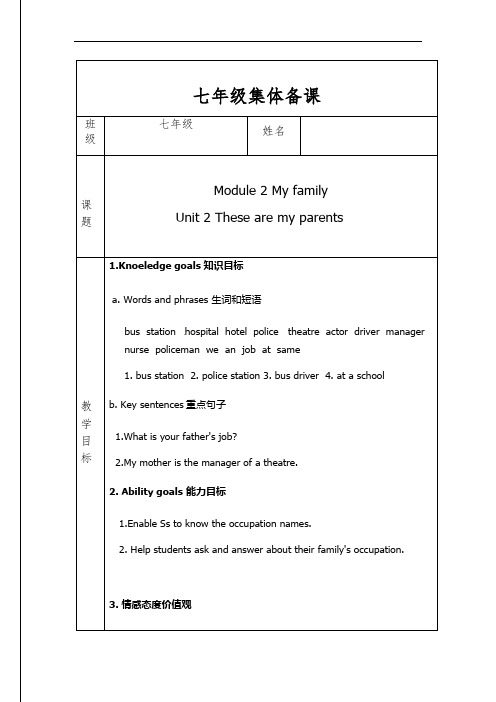
1.Knoeledge goals知识目标a. Words and phrases 生词和短语bus station hospital hotel police theatre actor driver manager nurse policeman we an job at same1. bus station2. police station3. bus driver4. at a schoolb. Key sentences重点句子1.What is your father's job?2.My mother is the manager of a theatre.2. Ability goals 能力目标1.Enable Ss to know the occupation names.2. Help students ask and answer about their family's occupation.3. 情感态度价值观places and the jobs.Places : hospital , hotel , school , bus station , theatreJobs : doctor , nurse , hotel manager , teacher , driver , actor…T: Do you like these pictures? Who works in it? yourfather or your mother?S:Yes, I do.My mother works in a ...My father works in a ...Step II :Learn the new words教教学过程T: Now look at the photos.This is a policeman. He works in a police station.These are nurses. They work in a hospital.T: When you see a man or a woman, What jobs can you think of?Then let the students remember the words.Step III Read and answer1. Betty's parents works in a ______.2. Lingling's mother and Daming's motherare_________.3. Tony's father is a _________, his mother is a _________.4. Daming's father is a _________.5. Lingling's father is a _________.Check the answers:1. theatre2. nurses3. manager4. teacher5. policeman6. bus driverStep IV :Complete the tableStep V: Work in pairsA:Where is Betty from?B:She's come from America.A:What is her father's job?B:He's an actor.A:Is Tony's father a manager?B:Yes, he is.A:Is Daming's father a drver?B:No, he isn't .He's a policeman.A:What is your father's job?B:My father's a ...Step VI : Language points1.These are Betty's parents.这两位是贝蒂的父母。
外研版初中英语七年级上册教案Module 2 Unit 2 These are my parents

Book 1 Module 2 My Family一、教学内容:Unit2 These are my parents二、课型:Reading and writing三、教学目标:1.To read the passage aloud and find specific information about people2.To learn some key words and useful eation using punctuation (capital letters and full st ops) correctly四、教学重难点:1、能阅读和介绍人物职业和工作地点的简短文章。
2、能写出简短的句子来介绍家庭成员,并能正确运用大小写以及句号。
3、能运用指示代词和名词所有格,运用人称代词的主格形式和形容词性物主代词。
五、教学准备:课堂整体运用任务型教学模式以及阅读课“四个阶段”教学模式。
本课指导学生通过阅读获取信息,培养学生阅读技能。
在教学过程中,采用多媒体手段辅助教学,利用各种图片和习题任务贯穿整个教学过程。
因此,本节课需准备:PPT课件、挂图、录音机、课堂练习表格、奖品.六、预习要求:根据音标自学本课新单词;七、教学过程:1. Scanning(1)Ask students to scanthe passage and write the letters of the pictures in Activity 1.2. SkimmingAsk students to skim the passage and complete the table in Activity 4.3.Careful reading.(1)Paragraph 1.2①Choose the best answers 1.Scan the passage and write the letters of the pictures in Activity 1.2.Skim the passage and complete the table in Activity 4.①Read paragraph1 a nd choose the best answers in groups.(2)Paragraph 3-4:①Read paragraph 3-4 and check the true sentences . ①Students check the true sentences about paragraph 3-4also correct the wrong sentences1. Tony is from England.1. Organize the Ss t o introduce Betty, Daming, Tony and Lingling with the information in the table in Activity 4.2. Activity 6: Have the Ss to work i n pa irs, asking and answering the questions.3. Writing(Activity 5)①Look at the sentences and underline capital letters and full stops .②Ask some students to show out their answers .③explain the use of capital letters and full stops . 2. Asking and answering the questions in pairs in Activity 6. Then introduce their partner’s father and mother.3. Show out their answers and ta ke a note.课后作业有助于学a big/small family,there are, people,grandma, grandpa,mother, father,uncle, aunt, sister,brother, cousin, job,worker, teacher.八、板书设计:Module2 My Family 小组评价Unit 2 These are my parents T1 T2 T3 Work in pairs.This is …She/He is from …My mother is…My father’s job is …She/He works at …达标训练题一、根据句意写单词。
外研版Module2 Unit2教学设计
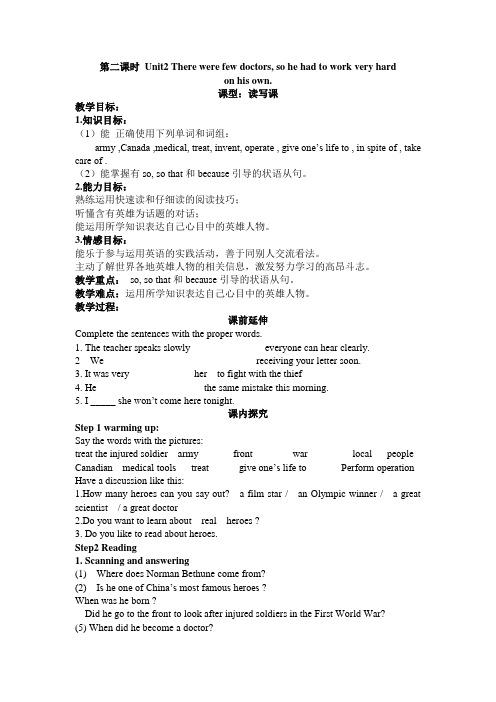
第二课时Unit2 There were few doctors, so he had to work very hardon his own.课型:读写课教学目标:1.知识目标:(1)能正确使用下列单词和词组:army ,Canada ,medical, treat, invent, operate , give one’s life to , in spite of , take care of .(2)能掌握有so, so that和because引导的状语从句。
2.能力目标:熟练运用快速读和仔细读的阅读技巧;听懂含有英雄为话题的对话;能运用所学知识表达自己心目中的英雄人物。
3.情感目标:能乐于参与运用英语的实践活动,善于同别人交流看法。
主动了解世界各地英雄人物的相关信息,激发努力学习的高昂斗志。
教学重点:so, so that和because引导的状语从句。
教学难点:运用所学知识表达自己心目中的英雄人物。
教学过程:课前延伸Complete the sentences with the proper words.1. The teacher speaks slowly _____ _______ everyone can hear clearly.2 We _____ _______ ________ _____ receiving your letter soon.3. It was very _____ _____ her to fight with the thief4. He ________ _________ the same mistake this morning.5. I _____ she won’t come here tonight.课内探究Step 1 warming up:Say the words with the pictures:treat the injured soldier army front war local people Canadian medical tools treat give one’s life to Perform operation Have a discussion like this:1.How many heroes can you say out? a film star / an Olympic winner / a great scientist / a great doctor2.Do you want to learn about real heroes ?3. Do you like to read about heroes.Step2 Reading1. Scanning and answering(1) Where does Norman Bethune come from?(2) Is he one of China’s most famous heroes ?When was he born ?Did he go to the front to look after injured soldiers in the First World War?(5) When did he become a doctor?2.Careful readingCheck the true sentences.(1)Norman Bethune gave his life to helping the Japanese people.( )(2) He is one of England’s most famous heroes. ( )(3 )He invented medical tools to use inside hospital. ( )(4) He invented new treatments to help soldiers .( )(5) He opened hospitals to train doctors and nurses. ( )(6) When he was tired ,he stopped to have a rest. ( )(7) Once he performed operations for 59 hours without stopping. ( )(8) In the end he died because he was tired .( )(9) He cut his hand during an operation .( )(10) He is remembered in both Canada and China. ( )Read the passage and fill in the blanks.1. 白求恩在中国是最著名的英雄之一,但他不是中国人,是加拿大人。
外研版英语七年级上StarterModule2Unit2教案

Unit 2 Please touch your head.ⅠAnalysis of the text:In this text students will learn the names of body.ⅡArrangement of teaching in this moduleThree periods for this module, one period for one unit.ⅢTeaching focus:ⅰ Master language of asking the name of body and master the names of body.Key vocabulary and phrases: head, arm, hand, leg, foot, hair, eye, ear, nose, mouth, What are these? .Grammar: The singular and plural forms of nouns, be动词is, are, instruction pronoun these.ⅱBe skilled in oral expression of asking the name of specific part’s name of body.ⅣTeaching aims:ⅰ Function: recognition of parts of body.ⅱListening: Students can understand others’ questions of asking the name s of specific parts of body, and give corresponding answers.ⅲ Speaking: Students can ask and answer parts of body’s names.ⅳReading: Students can understand the similar dialogue of asking and answering parts of body’s names.ⅴ Writing: Students can write the names of parts of body.ⅤTeaching Procedures:Part I: Lead in:Step 1: Review the objects’ names in the classroom.Step 2: Point one object and ask students to give its name.Part II: V ocabulary study:Step 1: Show some pictures of parts of body by PPT, give students the names of the these parts.Step 2: Play the recording and have them point out the words and phrases in Activity 1.Step 3: Play the recording again and have them read after the tape.Step 4: Play the recording and have the students match the words with the pictures in Activity 3.Step 5: Work in pairs , one point one part of body, the other say the English name of it.PartⅢ: Grammar study:Step 1: Learn●the singular and plural forms of nouns,●be动词is, are,●instruction pronoun these.●article a, anStep 2: Have students practise previous grammar knowledge by filling the blanks in Activity 5.Step 3: Play the recording and check the answers of Activity 5.PartⅣ: Dialogue study:Step 1: Play the recording and have students number the dialogues.Step 2: Work in pairs and make dialogue as:---What’s this?---It’s an arm.---What are these?---These are feet.Step 3: Work in pairs and play a game of “Touch your head.”。
- 1、下载文档前请自行甄别文档内容的完整性,平台不提供额外的编辑、内容补充、找答案等附加服务。
- 2、"仅部分预览"的文档,不可在线预览部分如存在完整性等问题,可反馈申请退款(可完整预览的文档不适用该条件!)。
- 3、如文档侵犯您的权益,请联系客服反馈,我们会尽快为您处理(人工客服工作时间:9:00-18:30)。
七年级英语(上)导学案
主备人完成时间议课时间发放时间上课时间审核人胡文达第三周第四周第四周第五周梁结彩班级姓名小组
学习目标1.能阅读介绍人物职业的简短文章。
2.能写出有关职业的简短句子;能分清大小写及正确的使用句号。
3.能运用所学知识向朋友咨询情况,介绍自己和家人的职业。
词汇和短语:
bus station hospital hotel police theatre actor driver manager nurse policeman we an job at same bus station bus station bus driver at a school 句型:
(1)What is your father’s job?
(2)My mother is the manager of a theatre.
学习重点、难点1.能够正确掌握重点的词汇和词组并能正确运用。
2.正确使用名词所有格。
学一、课前预习
1. 根据音标拼读module 2(10-11)的单词并熟记中文意思。
(个
人独立完成)
2. 完成同步导学与优化训练P24的自主预习部分。
二、复习与点评
教学反思
在新课改的形式下,如何激发教师的教研热情,提升教师的教研能力和学校整体的教研实效,是摆在每一个学校面前的一项重要的“校本工程”。
所以在学习上级的精神下,本期个人的研修经历如下:
1.自主学习:我积极参加网课和网上直播课程.认真完成网课要求的各项工作.教师根据自己的专业发展阶段和自身面临的专业发展问题,自主选择和确定学习书目和学习内容,认真阅读,记好读书笔记;学校每学期要向教师推荐学习书目或文章,组织教师在自学的基础上开展交流研讨,分享提高。
2.观摩研讨:以年级组、教研组为单位,围绕一定的主题,定期组织教学观摩,开展以课例为载体的“说、做、评”系列校本研修活动。
3.师徒结对:充分挖掘本校优秀教师的示范和带动作用,发挥学校名师工作室的作用,加快新教师、年轻教师向合格教师和骨干教师转化的步伐。
4.实践反思:倡导反思性教学和教育叙事研究,引导教师定期撰写教学反思、教育叙事研究报告,并通过组织论坛、优秀案例评选等活动,分享教育智慧,提升教育境界。
5.课题研究:立足自身发展实际,学校和骨干教师积极申报和参与各级教育科研课题的研究工作,认真落实研究过程,定期总结和交流阶段性研究成果,及时把研究成果转化为教师的教育教学实践,促进教育质量的提高和教师自身的成长。
6.专题讲座:结合教育教学改革的热点问题,针对学校发展中存在的共性问题和方向性问题,进行专题理论讲座。
7.校干引领:从学校领导开始,带头出示公开课、研讨课,参与本校的教学观摩活动,进行教学指导和引领。
8.网络研修:充分发挥现代信息技术,特别是网络技术的独特优势,借助教师教育博客等平台,促进自我反思、同伴互助和专家引领活动的深入、广泛开展。
我们认识到:一个学校的发展,将取决于教师观念的更新,人才的发挥和校本培训功能的提升。
多年来,我们学校始终坚持以全体师生的共同发展为本,走“科研兴校”的道路,坚持把校本培训作为推动学校建设和发展的重要力量,进而使整个学校的教育教学全面、持续、健康发展。
反思本学期的工作,还存在不少问题。
很多工作在程序上、形式上都做到了,但是如何把工作做细、做好,使之的目的性更加明确,是继续努力的方向。
另外,我校的研修工作压力较大,各学科缺少领头羊、研修氛围有待加强、师资缺乏等各类问题摆在我们面前。
缺乏专业人员的引领,各方面的工作开展得还不够规范。
相信随着课程改革的深入开展,在市教育教学研究院的领导和专家的亲临指导下,我校校本研修工作一定能得以规范而全面地展开。
“校本研修”这种可持续的、开放式的继续教育模式,一定能使我校的教育教学工作又上一个台阶。
为了更好地开展以后的工作,现就以下方面做如下总结:
一、不断提高业务水平
我树立优良学风,刻苦钻研业务,不断学习新知识,探索教育教学新规律。
钻研教材,写好每一个教案,上好每一堂课,多听同组同事的课,多学习别人的优点和长处。
另外,为业余时间多学习信息技术,适应现代教学的要求。
二、不断加强学习
只有学习,才能不断进步和成长,让学习成为提高自己的渠道,让学习成为我一生的精神财富,做一名学习型教师。
所以,我就多读书,多学习,多写读书笔记。
三、学习运用科学的教育教学模式
在课改的课堂教学中,不断探索适合学生愉悦学习的好的教学模式,向同组的老师学习先进教学方法。
尤其在阅读教学中,我注意学习其他老师的先进经验,让学生在朗读中感悟,提高阅读能力。
、培养学生课堂上会静下心来思考的能力。
有些同学的特点是比较浮躁,在问题面前不知从哪儿下手回答,甚至没有读清问题的要求,就开始回答。
这学期我在课堂上引导学生在这方面有所提高。
、善于总结自己在教育教学中的点点滴滴,严以律己,从小事做起,当学生的表率。
从小事中总结大道理,不断改进自己的教育方式。
四、积极参加上级领导组织的各项教育教学学习活动,提高自己的教研能力。
积极订阅教育教学有帮助的刊物,学习其中先进的教育教学经验,不断提高自己的教育教学水平。
、在课改中,多和同组的老师一起备课,一起商量课堂中出现的问题。
尤其在阅读教
学中,多向有经验的老师请教,在课堂中怎样激发学生的阅读兴趣,怎样培养学生探究性的阅读能力,最后提高学生的写作水平。
五、勤思考,多动笔
每周坚持写教学心得;可以是备课心得,也可以是教学体会,可以写课堂教学方法实施体会,也可以反思上节课存在的问题,然后找出好的方法解决它。
善于积累总结教育教学中和班级管理中的一些典型的事情。
从这些事情中,不断反思自己的教育教学行为,对于好的做法积累经验,对于不好的做法及时反思及时改正。
以此提高自己的教育教学水平。
在以后的研修中,我会继续努力学习,让我把一生矢志教育的心愿化为热爱学生的一团火,将自己最珍贵的爱奉献给孩子们,相信今日含苞欲放的花蕾,明日一定能盛开绚丽的鲜花。
相信在我的教学生涯中一定能更上一层楼。
